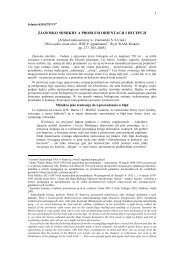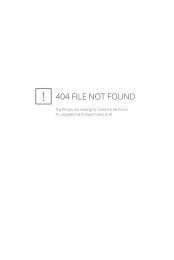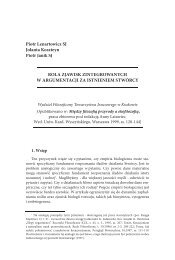the body-mind dichotomy a problem or artifact? - Piotr Lenartowicz SJ
the body-mind dichotomy a problem or artifact? - Piotr Lenartowicz SJ
the body-mind dichotomy a problem or artifact? - Piotr Lenartowicz SJ
Create successful ePaper yourself
Turn your PDF publications into a flip-book with our unique Google optimized e-Paper software.
17<br />
DNA molecule, descibed in every academic textbook of biochemistry.<br />
32<br />
(vi) The selective activity of <strong>the</strong> cell affected by DNA mutations .<br />
(vii) The highly selective re<strong>or</strong>ganization of <strong>the</strong> segments of DNA molecules during<br />
33<br />
<strong>the</strong> cell life cycle .<br />
34<br />
(viii) The repair of <strong>the</strong> operon structures .<br />
Paul Weiss has created a st<strong>or</strong>y of Martians who observed our Earth from a distance<br />
and who came to <strong>the</strong> conclusion that <strong>the</strong> only living entities here move with considerable<br />
speed along <strong>the</strong> highways. Those living entities were of different sizes, shapes<br />
and colours and, acc<strong>or</strong>ding to <strong>the</strong> Martian hypo<strong>the</strong>ses, were susceptible to a dangerous<br />
infection caused by viruses of quite identical shapes, with a globe on one end and four<br />
long, flexible appendices protruding out from <strong>the</strong> center, filled with a red fluid. The<br />
four-wheeled living creatures usually died because of this infection. This was easily<br />
demonstrable because in every case of disintegration, which usually happened while<br />
moving along <strong>the</strong> highway, <strong>the</strong> ruined inside of a dead <strong>body</strong> was filled with <strong>the</strong> redfluid-leaking<br />
viruses.<br />
The parable of <strong>the</strong> Martian observers helps to illustrate how a too narrow, „analytical”<br />
field of observation can twist <strong>the</strong> results of rational thinking.<br />
A special kind of causality<br />
The rational-like dynamism of any known living <strong>body</strong> postulates a special kind of cau-<br />
35<br />
sality – integrating many different physico-chemical f<strong>or</strong>ms of influence . It does not<br />
replace <strong>the</strong> in<strong>or</strong>ganic f<strong>or</strong>ms of causality, it does not change <strong>the</strong>ir interactions and influ-<br />
32<br />
Cfr. Cairns J., Overbaugh Julie, Miller S. (1988). The <strong>or</strong>igin of mutants. Nature 335, 142-<br />
145.; Parker J. (1989). Err<strong>or</strong>s and alternatives in reading <strong>the</strong> universal genetic code.<br />
Microbiol. Revs, 53, 273-298.<br />
33<br />
Soll D. R., Mitchell L., Kraft B., Alexander S., Finney R., Barbara Varnum-Finney.<br />
(1987). Characterization of a timing mutant of Dictyostelium discoideum which exhibits<br />
„high frequency switching”. Dev. Biol. 120, 25-37;<br />
Stragier P., Kunkel Barbara, Kroos L., Losick R. (1989). Chromosomal rearrangement<br />
generating a composite gene f<strong>or</strong> a developmental transcription fact<strong>or</strong>. Science 243, 507-<br />
512;<br />
Newman R. A. (1992). Adaptive plasticity in amphibian metam<strong>or</strong>phosis. BioScience 42,<br />
671-678;<br />
Prescott D. M. (1992) Cutting, splicing, re<strong>or</strong>dering, and elimination of DNA sequences in<br />
hypotrichous ciliates. BioEssays 14, 317-324;<br />
Ohta T. (1992). The meaning of natural selection revisited at <strong>the</strong> molecular level. Trends in<br />
Ecology & Evolution 7, 311-312.<br />
34<br />
Cfr. Higgins N. P. (1992). Death and transfiguration among bacteria. TIBS 17, 207-211.<br />
35<br />
This idea is developed in H. Driesche's Philosophie des Organischen. See in particular<br />
<strong>the</strong> chapters Entelechie und das Prinzip der Erhaltung der Energie (p. 294 ss.) and Entelechie<br />
und der Satz des Geschehens (p. 298 ss.). See also Caws P. (1965. The philosophy of<br />
science. Princeton, N. Jersey, p. 311) who doesn't seem to grasp <strong>the</strong> imp<strong>or</strong>tance and <strong>the</strong> full<br />
meaning of <strong>the</strong> „negative” (restrictive, constraining) causality imposed by Driesche's „entelechia”.






